Solving these TS 10th Class Maths Bits with Answers Chapter 8 Similar Triangles Bits for 10th Class will help students to build their problem-solving skills.
Similar Triangles Bits for 10th Class
Question 1.
From the figure ∠DAC = ……………….
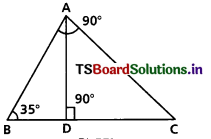
A) 35°
B) 55°
C) 45°
D) 60°
Answer:
A) 35°
Question 2.
The ratio of the corresponding sides of two similar triangles is 5 : 3 then the ratio of their areas
A) 5 : 3
B) 3 : 5
C) 6 : 10
D) 25 : 9
Answer:
D) 25 : 9
Question 3.
If ∆ABC ~ ∆DEF; BC = 4 cm, EF = 5 cm and ∆ABC = 80 cm2 then ∆DEF = ………………….
A) 100 cm2
B) 150 cm2
C) 125 cm2
D) 225 cm2
Answer:
C) 125 cm2
![]()
Question 4.
In the figure DE // BC and AD : DB = 1 : 2 then ∆ADE : ∆ABC =
A) 1 : 4
B) 4 : 1
C) 1 : 9
D) 2 : 9
Answer:
C) 1 : 9
Question 5.
∆ABC ~ ∆PQR. M is the mid point of BC. N is the mid point of QR. If the area of ∆ABC = 100 cm2 and area of ∆PQR = 144 cm2 and AM = 4 cm then PN = ………………… cm
A) 5 cm
B) 4.8 cm
C) 4 cm
D) 3.8 cm
Answer:
B) 4.8 cm
Question 6.
In ∆PQR, PQ = 6\(\sqrt{3}\) cm; PR = 12 cm, QR = 6 cm then ∠B = ………………..
A) 30°
B) 45°
C) 90°
D) 60°
Answer:
B) 45°
Question 7.
The lengths of diagonals of a rhombus are 24 cm and 32 cm then the perimeter of rhombus
A) 180°
B) 120°
C) 220°
D) 112°
Answer:
A) 180°
![]()
Question 8.
Which of the following does not belongs to side of right triangle ?
A) 9cm, 15cm, 12cm
B) 9cm, 5cm, 7cm
C) 400mm, 300mm, 500mm
D) 2cm, \(\sqrt{5}\) cm, 1cm
Answer:
B) 9cm, 5cm, 7cm
Question 9.
In an isosceles ∆PQR, PR = QR and PQ2 = 2PR2 then ∠R = ……………….
A) 60°
B) 30°
C) 90°
D) 45°
Answer:
C) 90°
Question 10.
In ∆ABC the mid points are D, E and F of the sides AB, BC, CA then ∆DEF : ∆ABC
A) 1 : 1
B) 1 : 3
C) 1 : 2
D) 1 : 4
Answer:
D) 1 : 4
Question 11.
The diagonal of a square is 7\(\sqrt{2}\) cm then its area
A) 28 cm2
B) 14\(\sqrt{2}\) cm2
C) 21 cm2
D) 49 cm2
Answer:
D) 49 cm2
![]()
Question 12.
In the figure AB = 2.5 cm, AC = 3.5 cm. If AD is the bisector of ∠BAC then BD : DC = …………..
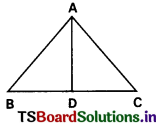
A) 5 : 3
B) 3 : 5
C) 5 : 7
D) 2 : 7
Answer:
C) 5 : 7
Question 13.
In the figure DE divides AB and AC in the ratio 1 : 3 If DE = 2.4 cm then BC = ………………
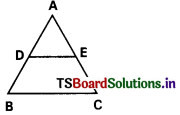
A) 4.8 cm
B) 7.2 cm
C) 9.6 cm
D) 12 cm
Answer:
B) 7.2 cm
Question 14.
The height of an equilateral triangle whose side is a unit
A) \(\frac{\mathrm{a}}{2}\)
B) \(\frac{\sqrt{3}}{2}\)a
C) \(\sqrt{3}\)a
D) \(\frac{\sqrt{3}}{4}\)a
Answer:
B) \(\frac{\sqrt{3}}{2}\)a
Question 15.
If ∆ABC ~ ∆XYZ, ∠C = 60° ∠B = 75° then ∠Z = ……………….
A) 90°
B) 75°
C) 45°
D) 60°
Answer:
D) 60°
![]()
Question 16.
Maximum possible tangents that can drawn to a circle is ………. (A.P. Mar. ’15)
A) Infinity
B) 4
C) 100
D) 2
Answer:
A) Infinity
Question 17.
∆ABC ~ ∆DEF and areas of ∆ABC, ∆DEF are 64 cm2 and 121 cm2 then the ratio of corresponding sides. (A.P. Mar. ’15)
A) 11 : 8
B) 8 : 11
C) 3 : 11
D) 19 : 8
Answer:
B) 8 : 11
Question 18.
Area of a regular hexagon whose side is ‘a’ cm is ………………. (A.P. Mar. ’15)
A) 6 \(\left(\frac{\sqrt{3}}{4} a^2\right)\)
B) 6 \(\left(\frac{3}{4} a^2\right)\)
C) \(\sqrt{6}\left(\frac{3}{4} a^2\right)\)
D) 6\(\left(\frac{\sqrt{3}}{4} a^2\right)\)
Answer:
D) 6\(\left(\frac{\sqrt{3}}{4} a^2\right)\)
Question 19.
If a man walks 6 m to East and 8m to North. Now he is at a distance of ……………… from origin point. (A.P. Mar.’15 )
A) 10 m
B) 48 m
C) 14 m
D) 2 m
Answer:
A) 10 m
![]()
Question 20.
∠CAD in the given figure is …………………
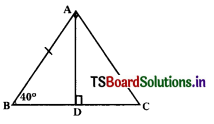
A) 50°
B) 60°
C) 40°
D) 90°
Answer:
A) 50°
Question 21.
Example for the sides of a Right angled triangle is …………….. (A.P. June ’15)
A) 5, 6, 9
B) 5, 12, 13
C) 5, 11, 12
D) 7, 8, 9
Answer:
B) 5, 12, 13
Question 22.
Height of an equilateral triangle whose side is ‘a’ cm is ……………. (A.P. Mar. ’16)
A) \(\frac{\sqrt{3}}{2}\)a
B) \(\frac{2}{\sqrt{3}}\)a2
C) \(\sqrt{\frac{3}{2}}\)a
D) \(\frac{\sqrt{3}}{2}\)a2
Answer:
A) \(\frac{\sqrt{3}}{2}\)a
Question 23.
∆ABC ~ ∆XYZ, ∠C = 60° ∠B = 70° then ∠ X = ……………… (A.P. Mar.’16)
A) ∠ X = 70°
B) ∠ X = 50°
C) ∠X = 60°
D) ∠X = 10°
Answer:
B) ∠ X = 50°
![]()
Question 24.
When we construct a triangle similar to a given triangle as per given scale factor, we construct on the basis of ………….. (T.S. Mar. ’15)
A) SSS similarity
B) AAA similarity
C) Basic proportionality theorem
D) A and C are correct
Answer:
C) Basic proportionality theorem
Question 25.
∆ABC ~ ∆DEF is given then which of the following is correct. (T.S. Mar. ’15)
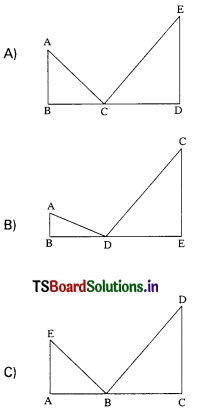
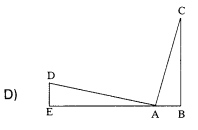
Answer:
(A)
Question 26.
In ∆ABC ∠C = 90°, BC = a, AB = c, AC = b and ‘p‘ is length of height drawn from ‘C’ to AB then ……… is correct. (T.S. Mar. ’15)
A) \(\frac{1}{\mathrm{p}^2}\) = \(\frac{1}{\mathrm{a}^2}\) – \(\frac{1}{\mathrm{b}^2}\)
B) \(\frac{1}{\mathrm{p}^2}\) = \(\frac{1}{\mathrm{b}^2}\) – \(\frac{1}{\mathrm{a}^2}\)
C) \(\frac{1}{\mathrm{p}^2}\) = \(\frac{1}{\mathrm{a}^2}\) + \(\frac{1}{\mathrm{b}^2}\)
D) \(\frac{2}{\mathrm{p}^2}\) = \(\frac{1}{\mathrm{a}^2}\) + \(\frac{1}{\mathrm{b}^2}\)
Answer:
C) \(\frac{1}{\mathrm{p}^2}\) = \(\frac{1}{\mathrm{a}^2}\) + \(\frac{1}{\mathrm{b}^2}\)
Question 27.
From the figure, x = …………………
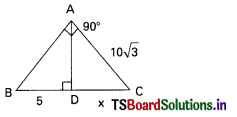
A) 10
B) 15
C) 12
D) 25
Answer:
B) 15
![]()
Question 28.
In the given figure, DE // BC and AD : DB = 5 : 4, then \(\frac{\text { D DEF }}{\text { D CFB }}\) =
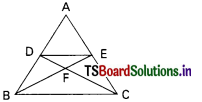
A) \(\frac{81}{25}\)
B) \(\frac{5}{9}\)
C) \(\frac{5}{4}\)
D) \(\frac{25}{81}\)
Answer:
D) \(\frac{25}{81}\)
Question 29.
In the figure, ∆ ABC is an isosceles triangle right angled at B. Two equilateral triangles are constructed with sides AC and BC. Then ∆ BCD = …………
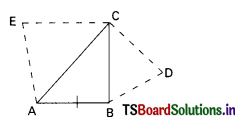
A) ∆ ACE
B) ∆ ABC
C) \(\frac{1}{2}\) (∆ ABC)
D) \(\frac{1}{2}\) (∆ ACE)
Answer:
D) \(\frac{1}{2}\) (∆ ACE)
Question 30.
In the figure ∆PQR and ∆SQR are two triangles on the same base QR. If PS intersects QR at ‘O’, then ∆PQR : ∆SQR = …………
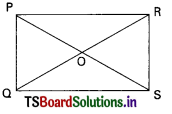
A) PO : SO
B) PQ : QS
C) PR : SR
D) PQ : SR
Answer:
A) PO : SO
Question 31.
In the figure, ∠BAD = ∠CAD; AB = 3.4 cm, BD = 4 cm, BC = 10 cm, then AC = ……………
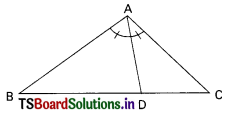
A) 5.1 cm
B) 3.4 cm
C) 6 cm
D) 5.3 cm
Answer:
A) 5.1 cm
Question 32.
All ……………… triangles similar.
A) equilateral
B) scalene
C) isosceles
D) none
Answer:
A) equilateral
![]()
Question 33.
Two polygons are similar if …………………
A) corresponding angles are equal
B) corresponding sides are equal
C) both A & B
D) none
Answer:
C) both A & B
Question 34.
The ratio of areas of two similar triangles is equal to the ratio of the squares of corresponding ……………
A) sides
B) areas
C) angles
D) none
Answer:
A) sides
Question 35.
A perpendicular is drawn from the vertex of a right angle to the hypotenuse then the tri-angles on each side of the perpendicular are ……………..
A) similar
B) not similar
C) square
D) none
Answer:
A) similar
Question 36.
If one angle of a triangle is equal to one angle of another triangle and the sides including these angles are proportional, the two triangles are similar. This property is …………………
A) SSS
B) ASA
C) AAA
D) SAS
Answer:
D) SAS
![]()
Question 37.
If the sides of two similar triangles are in the ratio 7 : 2 then the ratio of their areas is …………….
A) 9 : 2
B) 8 : 9
C) 4 : 49
D) 49 : 4
Answer:
D) 49 : 4
Question 38.
∆ABC ~ ∆PQR, ∠A = 32°, ∠R = 65° then ∠B = ………………
A) 64°
B) 73°
C) 83°
D) none
Answer:
C) 83°
Question 39.

If ∆ABC ~ ∆PQR then y + z = ……………..
A) 1 + 3\(\sqrt{3}\)
B) 4 + 3\(\sqrt{3}\)
C) 3\(\sqrt{3}\) + 7
D) 9 + \(\sqrt{3}\)
Answer:
B) 4 + 3\(\sqrt{3}\)
Question 40.
In ∆LMN, ∠L = 60°, ZM = 50° and ∆LMN ~ ∆PQR then ∠R = ……………..
A) 70°
B) 80°
C) 90°
D) none
Answer:
A) 70°
![]()
Question 41.
The perimeter of ∆ABC ~ ∆LMN are 60 cm and 48 cm of LM = 8 cm then AB = ………………. cm.
A) 19
B) 11
C) 7
D) 10
Answer:
D) 10
Question 42.
In ∆ABC, BC2 + AB2 = AC2 then ……………… is the right angle.
A) ∠B
B) ∠A
C) ∠C
D) none
Answer:
A) ∠B
Question 43.
The bisector of ∠A of ∆ABC intersects BC at D. If BD : DC = 4 : 7 and AC = 3.5. Then AB = ……………..
A) 2
B) 8
C) 10
D) 11
Answer:
A) 2
![]()
Question 44.
∆ABC ~ ∆PQR, ∠A = 50° then ∠Q + ∠R = ……………….
A) 120°
B) 110°
C) 130°
D) 180°
Answer:
C) 130°
Question 45.
In the figure, CD = …………….. cm.
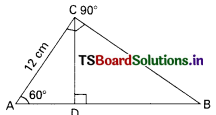
A) \(\sqrt{3}\)
B) 2\(\sqrt{3}\)
C) 3\(\sqrt{3}\)
D) 6\(\sqrt{3}\)
Answer:
D) 6\(\sqrt{3}\)
Question 46.
In the figure, AC = ……………. cm.
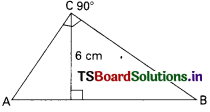
A) 19
B) 9
C) 12
D) 10
Answer:
C) 12
Question 47.
The ratio of corresponding sides of two similar triangles is 3 : 2 then the ratio of their corresponding heights is …………….
A) 3 : 2
B) 2 : 3
C) 1 : 4
D) 1 : 7
Answer:
A) 3 : 2
![]()
Question 48.
In the figure, ∠ABC = ………………..
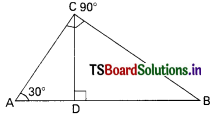
A) 30°
B) 70°
C) 50°
D) 60°
Answer:
D) 60°
Question 49.
In ∆ABC, XY || BC, AX : XB = 2 : 1 then ∆ AXY : ∆ABC = ………………
A) 9 : 4
B) 4 : 9
C) 1 : 9
D) 2 : 3
Answer:
B) 4 : 9
Question 50.
In a square, the diagonal is ………………. times of its side.
A) \(\sqrt{7}\)
B) \(\sqrt{3}\)
C) \(\sqrt{2}\)
D) 2
Answer:
C) \(\sqrt{2}\)
Question 51.
The side of an equilateral triangle is ‘a’ units. Its height is …………….. units.
A) \(\frac{\sqrt{3 a}}{2}\)
B) \(\frac{\sqrt{3}}{4}\)a
C) \(\frac{3}{a}\)
D) \(\frac{3}{2}\)
Answer:
A) \(\frac{\sqrt{3 a}}{2}\)
![]()
Question 52.
The ratio of the areas of two similar triangles is 1 : 4 then the ratio of their corresponding sides …………….
A) 9 : 1
B) 1 : 1
C) 2 : 1
D) 1 : 2
Answer:
D) 1 : 2
Question 53.
∆ABC ~ ∆PQR then AB : PQ = ……………….
A) AC : PR
B) AC : PQ
C) AB : PR
D) none
Answer:
A) AC : PR
Question 54.
∆ABC is an isosceles right triangle ∠C = 90° then AB2 = ……………….
A) AB2 + BC2
B) AC2 + BC2
C) AC2 + 2
D) none
Answer:
B) AC2 + BC2
Question 55.
Each angle in an equilateral triangle is ……………….
A) 60°
B) 80°
C) 100°
D) 70°
Answer:
A) 60°
![]()
Question 56.
Each exterior angle of an equilateral triangle is …………….
A) 180°
B) 130°
C) 110°
D) 120°
Answer:
D) 120°
Question 57.
The longest side in a right triangle is ……………..
A) smaller
B) hypotenuse
C) adjacent
D) none
Answer:
B) hypotenuse
Question 58.
In the figure, ∆ABC, DE // BC and \(\frac{A D}{D B}\) = \(\frac{3}{5}\), AC = 5.6 then AE = …………….. cm.
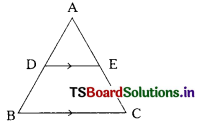
A) 1.8
B) 3.5
C) 1.2
D) 2.1
Answer:
D) 2.1
Question 59.
From the figure, AD = ……………. cm.
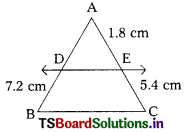
A) 2.4
B) 4.2
C) 8.2
D) 9.2
Answer:
A) 2.4
![]()
Question 60.
In the figure, LM // CB and LN // CD then \(\frac{A M}{A B}\) = ……………….
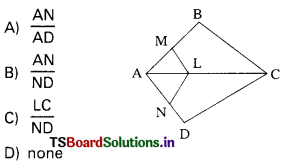
Answer:
(A)
Question 61.
In a trapezium, diagonals divide each other ………………
A) proportionally
B) not proportional
C) congruent
D) none
Answer:
A) proportionally
Question 62.
In ∆ABC, AB = BC = AC then ∠A = ∠B = ∠C = …………..
A) 70°
B) 60°
C) 80°
D) 90°
Answer:
B) 60°
Question 63.
In the figure, two triangles are similar then x = ……………… cm.
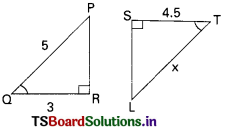
A) 9.3
B) 1.5
C) 7.5
D) 8.5
Answer:
C) 7.5
Question 64.
In the figure, x = …………… cm
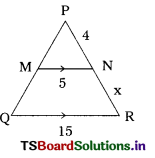
A) 10
B) 12
C) 9
D) 8
Answer:
D) 8
Question 65.
In the figure, x = ……………. cm.
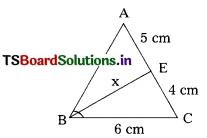
A) 12 cm
B) 8 cm
C) 3 cm
D) data is not sufficient
Answer:
D) data is not sufficient
Question 66.
∆ABC ~ ∆PQR, ∠A + ∠B = 100°, ∠R = ……………
A) 60°
B) 80°
C) 90°
D) 100°
Answer:
B) 80°
![]()
Question 67.
∆ABC ~ ∆DEF and their areas are respectively 64 cm2 and 121 cm2 if EF = 15.4 cm then BC = …………….. cm.
A) 10.2
B) 8.7
C) 11.2
D) 10.3
Answer:
C) 11.2
Question 68.
Which of the following are the sides of a right triangle ?
A) 10 cm, 8 cm, 6 cm
B) 12 cm, 1 cm, 9 cm
C) 3 cm, 5 cm, 12 cm
D) all
Answer:
A) 10 cm, 8 cm, 6 cm
Question 69.
From the figure y = …………….. cm.
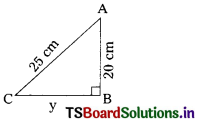
A) 9
B) 10
C) 12
D) 15
Answer:
D) 15
Question 70.
The diagonal of a trapezium ABCD in which AB // CD intersect at ‘O’. If AB = 2CD then the ratio of areas of triangles AOB and COD is …………….
A) 14 : 1
B) 1 : 2
C) 1 : 9
D) none
Answer:
D) none
![]()
Question 71.
∆ABC ~ ∆DEF and 2AB = DE and BC = 8 cm then EF = ………………. cm.
A) 16
B) 19
C) 12
D) none
Answer:
A) 16
Question 72.
∆ABC ~ ∆DEF, BC = 4 cm, EF = 5 cm and area of ∆ABC = 80 cm2 then area of ∆DEF = …………… cm2.
A) 105
B) 165
C) 125
D) none
Answer:
C) 125
Question 73.
In the figure PQR, ∠QPR = 90°, PQ = 24 cm and QR = 26 cm and in ∆PKR, ∠PKR = 90° and KR = 8 cm then PK = ……………… cm.
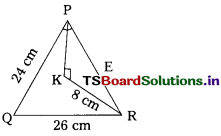
A) 10
B) 6
C) 19
D) 8
Answer:
B) 6
Question 74.
In the figure, QA ⊥ AB and PB ⊥ AB if AO = 20 cm, BO = 12 cm, PB = 18 cm then AQ = ……………. cm.
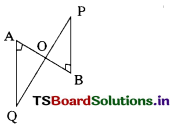
A) 70
B) 60
C) 40
D) 30
Answer:
D) 30
![]()
Question 75.
In the figure, ∠A = ∠B and AD = BE then …………
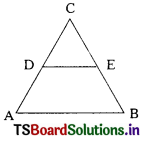
A) DE // AB
B) DE = AB
C) CD = EB
D) none
Answer:
A) DE // AB
Question 76.
In the figure, in ∆PQR, QR // ST, \(\frac{\mathrm{PS}}{\mathrm{SQ}}\) = \(\frac{3}{5}\) and PR = 28 cm then PT = ……………. cm.
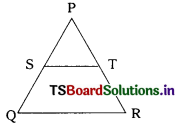
A) 6.5
B) 10.5
C) 8.1
D) 3.3
Answer:
B) 10.5
Question 77.
In an equilateral triangle ABC, AD ⊥ BC meeting BC in D then AD2 = …………….
A) 3 BD2
B) BD2
C) AB2
D) none
Answer:
A) 3 BD2
Question 78.
In the figure, if AB // CD then x = …………….. cm.
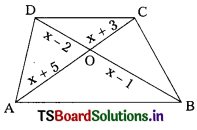
A) 10
B) 12
C) 7
D) 9
Answer:
C) 7
Question 79.
If the diagonals in a quadrilateral divide each other proportionally then it is ………….
A) square
B) trapezium
C) triangle
D) none
Answer:
B) trapezium
![]()
Question 80.
In the figure, DE // AB and FE // DB then DC2 …………….
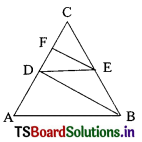
A) CF × AC
B) FE × AB
C) CF × FD
D) none
Answer:
A) CF × AC
Question 81.
D, E and F are the mid points of the sides BC, CA and AB respectively of ∆ABC then the ratio of the areas of ∆DEF and ABC = …………..
A) 1 : 9
B) 2 : 1
C) 1 : 2
D) 1 : 4
Answer:
D) 1 : 4
Question 82.
In the figure \(\frac{\mathrm{PS}}{\mathrm{SQ}}\) = \(\frac{\mathrm{PT}}{\mathrm{TR}}\) and ∠PST = ∠PRQ then ∆PQR is ………………. triangle.
A) isosceles
B) equilateral
C) scalene
D) none
Answer:
A) isosceles
![]()
Question 83.
Side of a rhombus is 4 cm then its perimeter is ……………. cm
A) 22
B) 21
C) 16
D) 20
Answer:
C) 16
Question 84.
In the figure, x = ………………
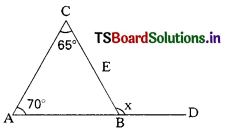
A) 130°
B) 135°
C) 45°
D) 15°
Answer:
B) 135°
Question 85.
Two sides of a right triangle are 3 cm and 4 cm then the third side is …………… cm.
A) 9
B) 6
C) 6.1
D) 5
Answer:
D) 5
Question 86.
∆ABC ~ ∆PQR, AB : PQ = 3 : 4 then ar ∆ ABC : ar ∆ PQR = ……………
A) 9 : 16
B) 9 : 1
C) 16 : 9
D) none
Answer:
A) 9 : 16
![]()
Question 87.
If 82 + 152 = k2 then k = ………………
A) 16
B) 17
C) 19
D) 20
Answer:
B) 17
Question 88.
The angles of a triangle arc in the ratio 1 : 2 : 3 then the largest angle is ………………
A) 70°
B) 60°
C) 90°
D) 20°
Answer:
C) 90°
Question 89.
Straight angle means ………………..
A) 180°
B) 190°
C) 200°
D) 100°
Answer:
A) 180°
![]()
Question 90.
In the figure, PQ // MN, \(\frac{\mathrm{K P}}{\mathrm{P M}}\) = \(\frac{4}{13}\) and KN = 20.4 cm then KQ ……………… = cm.
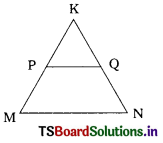
A) 6.3
B) 4.8
C) 1.8
D) 2.8
Answer:
B) 4.8
Question 91.
In the figure DE // BC if AD = x, AE = x + 2, DB = x – 2 and CE = x – 1 then x = ………………
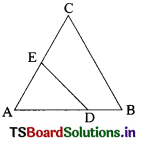
A) 4
B) 5
C) 6
D) 7
Answer:
A) 4
![]()
Question 92.
∆ABC ~ ∆DEF if DE : AB = 2 : 3 and ar ∆DEF = 44 sq. units then ar ∆ABC = ……………. sq.units.
A) 90
B) 101
C) 99
D) 110
Answer:
C) 99